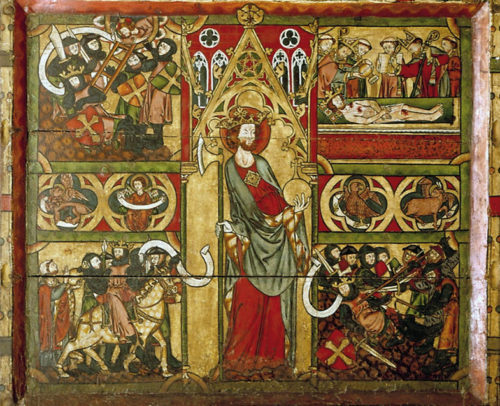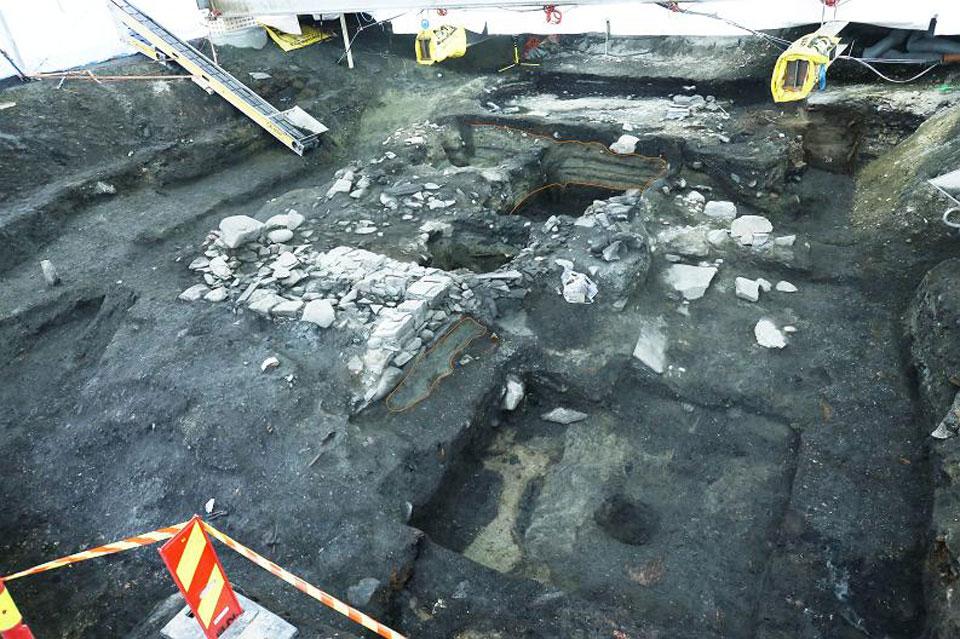St. Olaf (995 – 1030) was king of Norway from 1015 – 1028. The first Scandinavian king to be canonized, the whereabouts of his first shrine was lost after the Reformation. In 2016, it was located by archaeologists in Trondheim. Now, it seems, an early Viking settlement has been found below.
In late 2016, archaeologists found what is believed to be the remains of St. Clement’s Church in Trondheim. Considered the first church in Trondheim and the first resting place of the remains of St. Olaf this was in itself a sensation. Now, however, archaeologists are getting closer to uncover the context of the church.
Olaf Haraldsson

According to later chronicles and histories, spanning the period from 1160 – 1235 CE, he was born Ringerike and said to be a direct descendant of Harald Finehair. As befitted a Viking, he is said to have taken part in raids in Estonia, Finland, and later England, where some sources claim he was an ally of Aethelred the Unready trying to oust Canute the Great after his father Sweyn Forkbeard had died in 1014. After this, it is told, Olaf wintered in Rouen as a guest of Duke Richard II of Normandy, where the Duke’s brother, Robert the Dane baptised him in the cathedral. According to the Sagas, his one unwavering ambition was to unite Norway and bring it under his rule; at least large parts of Norway was believed to have been under the rule of the Danish kings from the time of Harold Bluetooth, who bragged about it on the Jelling Stone.
In 2015 Olaf returned to Norway, where he declared himself king and gave battle to the allies of the Danish kings, the earls of Lade. He was an ally of the King of Sweden, Olof Skötkunnung, whose daughter he married. However, his rule was short-lived. In 1026, he lost against King Cnut the Great at the Battle at Helgeå and experienced the loss of his ships, which were caught in the Baltic Sea. Cnut blockaded the narrow waters at Øresund, Storebælt, and Lillebælt, and Olaf had to march his army through the forests of Sweden. Later, he was driven into exile in Kiev. In 1029, he staged a short-lived comeback, but in 1030 he fell in the battle at Stiklestad.
Olaf the Saint
A year after his death, Olaf was declared a saint by Grimkell, who was later appointed the bishop of Selsey in England. He had taken up with the Norwegian king and was at the time of his death a member of his household. It is likely, though, that the foundation for his declaration as a saint was rather shaky. Many Norwegians living on the coast had been Christians since the time of Håkon the Good (c. 920 -961) and the mission had been well on its way for a long period when Olaf gained the throne. His canonization should likely be seen as a Norwegian (and English) counter-move to the probable effort made from Bremen and Germany to have Harold Bluetooth sanctified [1].
After 1035 and the death of Cnut the Great, the son of Olaf, Magnus the good, gained the throne in first Norway and later Denmark. It is during this period, the effort to spread the saintly fame of Olaf, increased. Thus, several of the very early churches in Denmark were later known to have been dedicated to St. Oluf. There was also a short-lived English cult and in 1050 Earl Siward dedicated a church in York to his name. In c. 1070, Adam of Bremen wrote about pilgrims going to Nidaros in Trondheim, the cathedral where his remains were later brought. This is the first evidence for a wider veneration of the royal saint. Later, St. Olaf became widely popular in Norway as well as the rest of Scandinavia
St. Clement
In 2016 archaeologists announced that they had in all likelihood found the remains of the church, where St. Olav was translated and canonised by Grimkell in 1031. The story goes that after the battle, his body was laid in a simple coffin and sailed to Trondheim where it was buries in a sandy bank up the river Nidelven. The following year, the coffin was taken up and reburied outside the church of St. Clement. Finally in August 1031, Grimkell dug it op once more and found the body to be fully preserved and sweet-scented. At this point Grimkell had his body translated and placed over the high altar. Later tradition claimed that Nidaros was built on top of the spot, where he had found his first resting place.
The archaeological excavations in 2016 uncovered the stone foundation for a wooden stave-church. At the end of the building, they found a small rectangular platform constructed of stones; in all likelihood, the foundation for an altar. A well was also found, which is believed to have been connected with the saint. The remains of the church have been dated to the beginning of the 11th century.
Hall Beneath
Recently, the archaeologists announced that they had found evidence of an earlier building beneath the church. This had been constructed with massive posts. Whether or not this building represents the remains of the royal hall, which Olaf according to the sagas, built at Trondheim awaits further excavations. So-far, the cultural layers has been dated to c. 900 -990. This seems to indicate there was a Viking settlement here at a much earlier point in time than expected. In the words of the excavation’s director Anna Petersén:
– This is a unique site in Norwegian history in terms of religion, culture and politics. Much of the Norwegian national identity has been established on the cult of sainthood surrounding St. Olaf, and it was here it all began!
Work on the site will continue this Spring and archaeological investigations will be carried out by personnel from The Norwegian Institute for Cultural Heritage Research (NIKU). The cost of this historic excavation is approximately 21 million NOK and is financed by the Directorate for Cultural Heritage. The excavation is expected to finish by the Summer
NOTES:
[1] This idea was floated by Niels Lund. See: Harald Blåtands død – og hans begravelse i Roskilde? By Niels Lund, Roskilde Museums Forlag, 1998
SOURCES:
Archaeologists in Norway find the church and altar of Viking king Olav Haraldsson
Press release by Thomas Wrigglesworth, NIKU – Norwegian Institute for Cultural Heritage Research
Unknown Viking settlement could be hidden beneath ancient church
Press release by Thomas Wrigglesworth, From ScienceNordic
READ MORE:
READ ALSO:
Save


